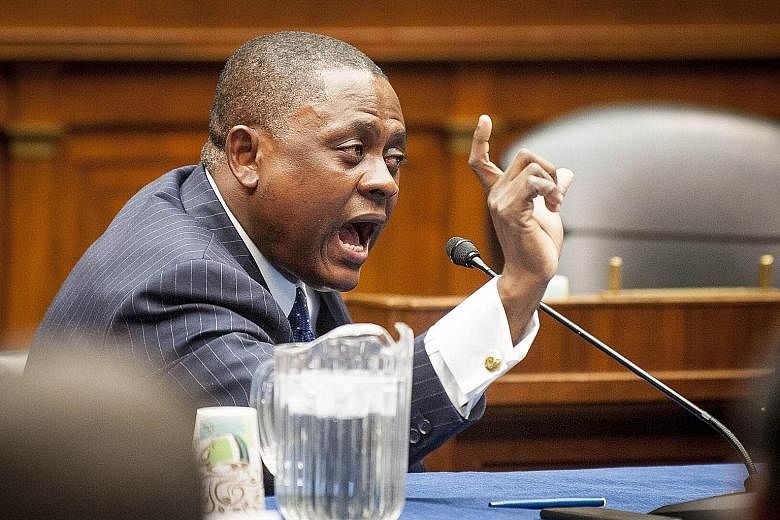Brain damage, once the big taboo side effect of sport, is inescapable today.
There is a movie, Concussion, starring Will Smith as Bennet Omalu, a Nigerian forensic pathologist who determined that a former Pittsburg Steelers NFL player died at 50 as a result of repeated blows to the head.
Omalu fought the establishment long and hard to establish that chronic traumatic encephalopathy (CTE) - the degenerative effects of repeated concussions - has led to suicides, memory loss, depression, dementia in many, many former All-American heroes.
The pathologist wouldn't be silenced, or bought off. The attorneys moved in. The National Football League ended up agreeing to a settlement that will cost it US$765 million (S$1.1 billion) to help 18,000 former players get treatment and compensation for debilitating neurological disorders.
The compensation part is still being contested. How do you put a price on the loss of a man's prime faculty, his brain and his personality, damaged in pursuit of a sport?

A few months ago, a high school in the US disbanded its American Football programme in favour of soccer.
But almost every day, and with good reason, Americans and others are jumpy about the way that soccer (to the rest of the world, football) sets a wretched example of ignoring head injuries and allowing groggy players, in the men's and women's game, to play on.
The high-profile case of Hugo Lloris, the Tottenham goalkeeper, being revived and playing on after the team manager overruled the doctor, still causes huge debate among the medical profession and the football administration.
At both the Fifa men's and women's World Cups in 2014 and 2015, there were alarming sights of players being laid out flat, and encouraged or allowed to play on.
The message hasn't yet penetrated the dressing room mentality that "real men" get up and play on. It is incredible because, way back in 1974 (yes, over 40 years ago) I worked for a series of articles with a leading British neuropathologist who examined the brains of former footballers and boxers and came to the same conclusions as Omalu.
That was, is, and for as long as reason prevails always will be, that if the brain is attacked it is: a) a life-threatening injury and b) repeated knocks risk permanent damage in later life.
The problem is that, unlike a broken limb or a blood injury, brain damage is insidious. The signs are not visible, even to trained medical experts.
Britain doesn't, yet, have the same imperative of a rapacious legal system that will chase the sports authorities for every dollar, as they do in America. The compensation culture is spreading, but the US is way ahead of that game.
However, a new research study into the links between concussion and degeneration is being launched in Britain.
It differs from the Omalu initiative, and from the work done in London over 40 years ago, in one vital aspect -the new study will examine the brains of the living, rather than making conclusions from the deceased.
The project is led by Dr Michael Turner who has spent 25 years as chief medical adviser to British horse racing, and at various times to tennis and skiing. He now has the funding and the cooperation, to examine the brains of more than 200 former jockeys in Britain, Ireland and France.
Using blood tests, MRI scans and neuropsychology screening, the doctor's team will compare results of those who have been knocked out on one or multiple occasions against those who have never lost consciousness.
Among the "guinea pigs" are the recently retired Tony McCoy, Richard Dunwoody, John Francome and Stan Mellor. All of them were champion jump jockeys - and all know the feeling of crashing down together with, often beneath, horses being brought down in failed attempts to clear fences at a galloping pace.
The jump jockeys are an endangered species. For once, statistics tell a useful tale here because in flat racing (where there are no jumps or hurdles) it has been calculated that a rider will fall 36 times in 8,568 rides.
Still painful, but not comparable to the jump jockeys. The statistics for those foolhardy fellows is that a rider will fall 54 times in every 794 rides.
And the figures comparing various sports shows that in every 1,000 hours participating, jump race riders can expect to suffer concussion 25 times, flat racers 17.1 times, boxers 11.2 times, rugby union 3.9 times, football 0.4 times and NFL 0.2 times.Those figures were last compiled nine years ago.
Dr Turner is starting his study with jump jockeys because he has their trust after being on hand to pick up their crumpled bodies from racetracks down the years. And because the riders themselves - especially the recently retired riders - are curious to know what is likely to happen as they age.
Dunwoody recalls at after-dinner speaking engagements that there were times of temporary memory loss in which he literally could not recall changing the training stable where he built up his reputation, or even leaving his wife.
He tells the stories with humour but acknowledges the consequences could be deadly.
The doctor in charge of the study suspects that, when he looks at the scans of recently retired jockeys, it could take 10 years for any degeneration to show. If he examines riders who retired 20 years ago, those signs might be visible much sooner.
"I suspect we will find some people are very susceptible to getting (brain) problems, others are not," says Dr Turner.
"That is the same that not every smoker gets lung cancer."
His aim is not to ban any sport, but to categorise the element of risks.
"One thing I hope we might be able to do is to identify high-risk groups," the doctor adds. "Why, for example, are females more susceptible to concussion than men? Is it because they have more swan-like necks? Is it genetics, or hormones, or something else?"?
Those are new questions to an old dilemma. Brain damage is insidious. Its repercussions can take so many years to show that it is then difficult to determine whether the blows of sport, or later lifestyle, caused the effects.
Brain damage is insidious. Its repercussions can take so many years to show that it is then difficult to determine whether the blows of sport, or later lifestyle, caused the effects.


